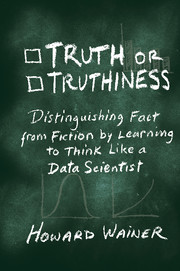Book contents
- Frontmatter
- Dedication
- Contents
- Preface and Acknowledgments
- Introduction
- Section I Thinking Like a Data Scientist
- Section II Communicating Like a Data Scientist
- 8 On the Crucial Role of Empathy in the Design of Communications: Genetic Testing as an Example
- 9 Improving Data Displays: Th e Media's and Ours
- 10 Inside Out Plots
- 11 A Century and a Half of Moral Statistics: Plotting Evidence to Aff ect Social Policy
- Section III Applying the Tools of Data Science to Education
- Section IV Conclusion: Don't Try Th is at Home
- Bibliography
- Sources
- Index
9 - Improving Data Displays: Th e Media's and Ours
from Section II - Communicating Like a Data Scientist
Published online by Cambridge University Press: 05 December 2015
- Frontmatter
- Dedication
- Contents
- Preface and Acknowledgments
- Introduction
- Section I Thinking Like a Data Scientist
- Section II Communicating Like a Data Scientist
- 8 On the Crucial Role of Empathy in the Design of Communications: Genetic Testing as an Example
- 9 Improving Data Displays: Th e Media's and Ours
- 10 Inside Out Plots
- 11 A Century and a Half of Moral Statistics: Plotting Evidence to Aff ect Social Policy
- Section III Applying the Tools of Data Science to Education
- Section IV Conclusion: Don't Try Th is at Home
- Bibliography
- Sources
- Index
Summary
Introduction
In the transactions between scientists and the media, influence flows in both directions. More than thirty years ago I wrote an article with the ironic title “How to Display Data Badly.” In it I chose a dozen or so examples of flawed displays and suggested some paths toward improvement. Two major newspapers, the New York Times and the Washington Post, were the source of most of my examples. Those examples were drawn over a remarkably short period of time. It wasn't hard to find examples of bad graphs.
Happily, in the intervening years those papers have become increasingly aware of the canons of good practice and have improved their data displays profoundly. Indeed, when one considers both the complexity of the data that are often displayed as well as the short time intervals permitted for their preparation, the results are often remarkable.
Eight years ago, over the course of about a fortnight, I picked out a few graphs from the New York Times that were especially notable. Over the same period I noticed decidedly inferior graphs in the scientific literature for data that had the same features. At first I thought that it felt more comfortable in the “good old days” when we scientists did it right and the media's results were flawed. But the old days were not actually so good. Graphical practices in scientific journals have not evolved as fast as those of the mass media. This year I redid the same investigation and reached the same conclusions. It is time we in the scientific community learned from the media's example.
Example 1: Pies
The U.S. federal government is fond of producing pie charts, and so it came as no surprise to see (Figure 9.1) a pie chart of the sources of government receipts. Of course, the grapher felt it necessary to “enliven” the presentation by adding a specious extra dimension, and to pull forward the segment representing corporate taxes, which has the unfortunate perceptual consequence of making that segment look larger than it is. Presenting the results for 2000 and 2007 together must have been to allow the viewer to see the changes that have taken place over that time period (roughly the span of the Bush administration). The only change I was able to discern was shrinkage in the contribution of individual income taxes.
- Type
- Chapter
- Information
- Truth or TruthinessDistinguishing Fact from Fiction by Learning to Think Like a Data Scientist, pp. 91 - 108Publisher: Cambridge University PressPrint publication year: 2015



